
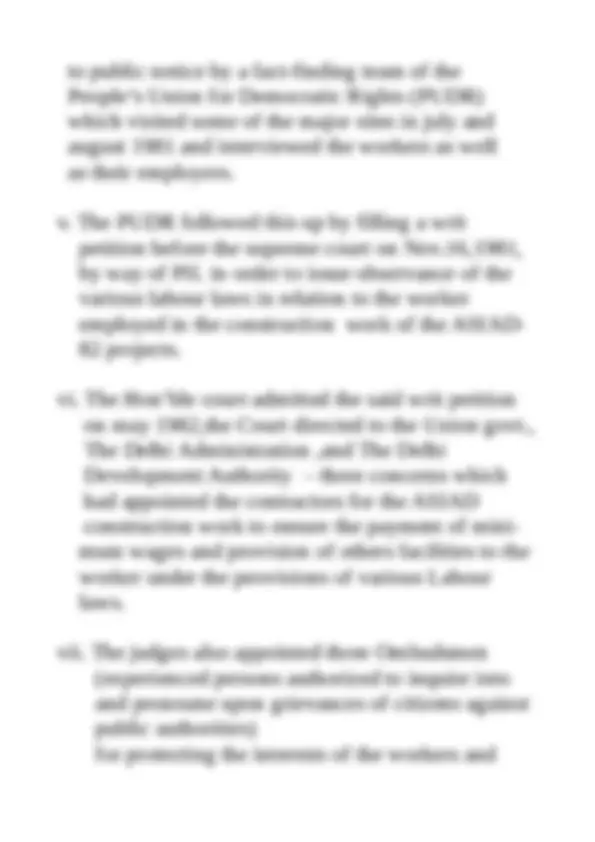
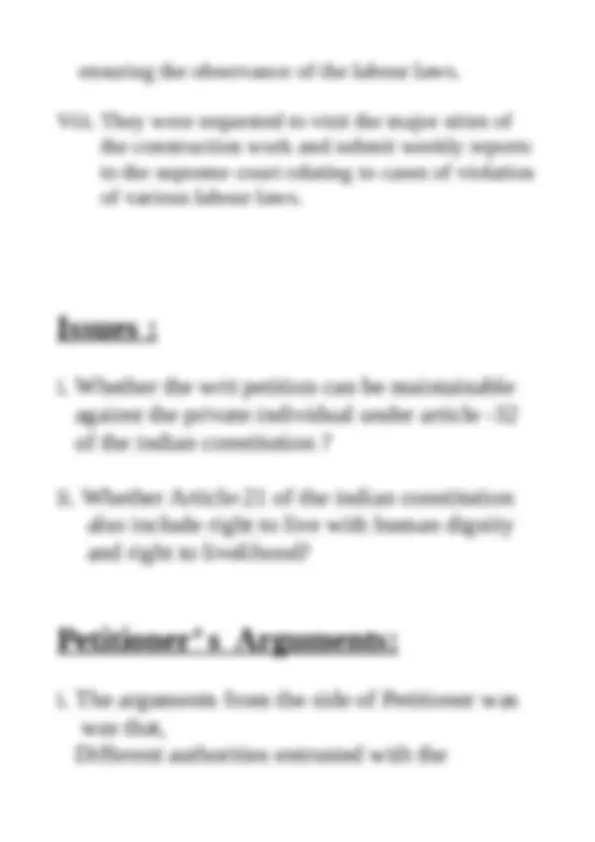
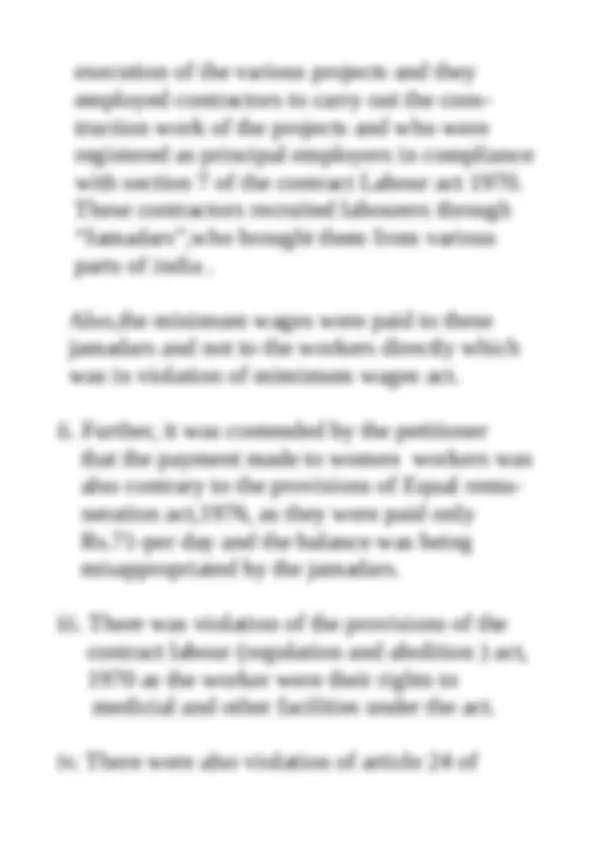
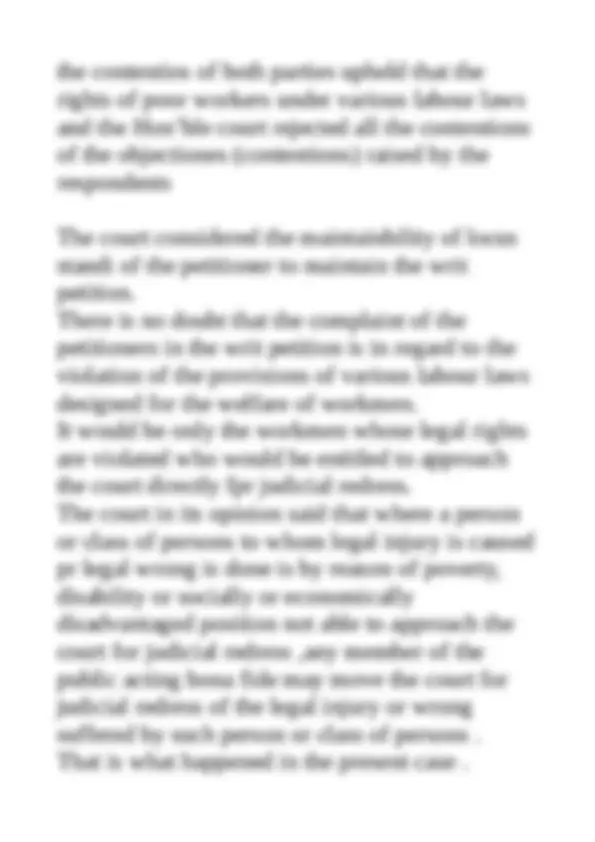
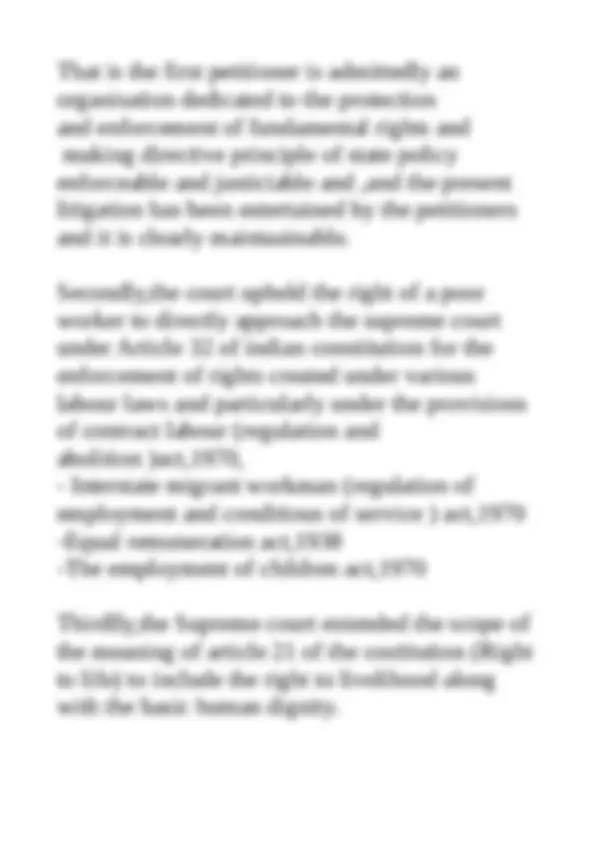
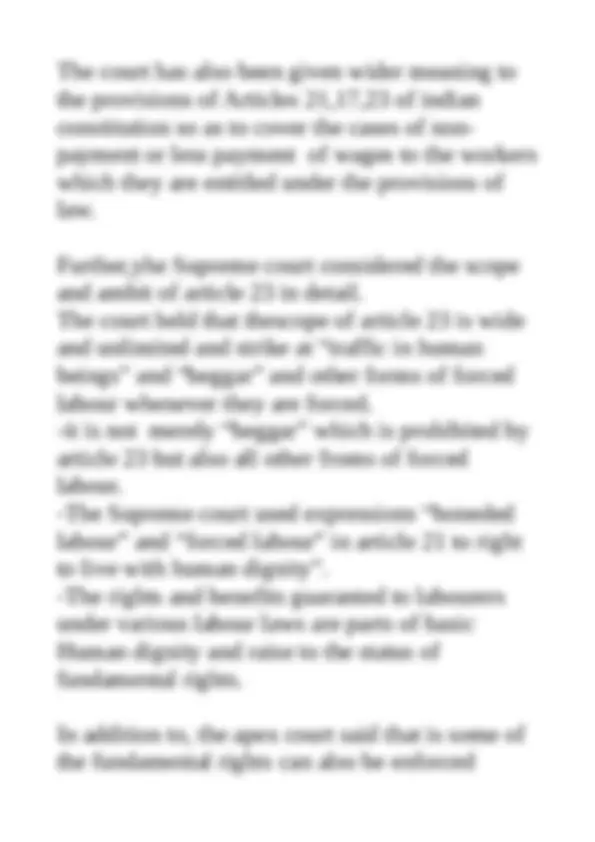


Study with the several resources on Docsity

Earn points by helping other students or get them with a premium plan


Prepare for your exams
Study with the several resources on Docsity

Earn points to download
Earn points by helping other students or get them with a premium plan
Community
Ask the community for help and clear up your study doubts
Discover the best universities in your country according to Docsity users
Free resources
Download our free guides on studying techniques, anxiety management strategies, and thesis advice from Docsity tutors
Act regulate the employment of labourer
Typology: Assignments
1 / 11

This page cannot be seen from the preview
Don't miss anything!







Submitted To : Res. Mam Dr.Harkirandeep Kaur Submitted By: Group III LL.B(TYC) Sem.5th
Facts of the Case: i. in this case there is a writ petition filled by way of public interest litigation in order to ensure obser- vance of the provisions of various labour law in rel- ation to workmen employed in the construction work of various projets connected with the ASIAN games. ii. There was a complaint of a violation of aritcle 24 of the constitution of India (which prohibits emplo- ing children below the age of 14 years in hazardous employment ) in this case on behalf of child laboure rs employed in the construction work in delhi. iii. Also, the labourers who worked on the ASIAD- sites both on the stadia and the infrastructure like flyovers and hotels, were recruited by agents of construction contractors from backward village of Orissa,Bihar,West Bengal,Madhya Pradesh and Rajasthan, working at a feverish pace, often far beyond the working hours fixed by laws without the minimum daily wages due to them living in hovels,their children dying of malnutrition and they themselves frequently becoming victims of accidents , these workers were forced to complete the ASIAD projects in time by Nov.19. iv. The terrible working and living conditions to which these workers were subjected to were first brought
ensuring the observance of the labour laws. Viii. They were requested to visit the major sities of the construction work and submit weekly reports to the supreme court relating to cases of violation of various labour laws.
i. Whether the writ petition can be maintainable against the private individual under article - of the indian constitution? ii. Whether Article-21 of the indian constitution also include right to live with human dignity and right to livelihood?
i. The arguments from the side of Petitioner was was that, Different authorities entrusted with the
execution of the various projects and they employed contractors to carry out the cons- truction work of the projects and who were registered as principal employers in compliance with section 7 of the contract Labour act 1970. These contractors recruited labourers through “Jamadars”,who brought them from various parts of india. Also,the minimum wages were paid to these jamadars and not to the workers directly which was in violation of mimimum wages act. ii. Further, it was contended by the petitioner that the payment made to women workers was also contrary to the provisions of Equal remu- neration act,1976, as they were paid only Rs.71-per day and the balance was being misappropriated by the jamadars. iii. There was violation of the provisions of the contract labour (regulation and abolition ) act, 1970 as the worker were their rights to medicial and other facilities under the act. iv. There were also violation of article 24 of
cause of action. ii. Also, it was claimed that the workmen whose rights were said to have been violated were employees of the contractors and not of the respondents. Also, the cause of action of workmen, if any, was therefore against the contractors and not against the respondents therefore no writ petition could lay against them. Iii. The respondent also claimed that; as part of this preliminary objection that no writ petition under Article 32 of indian constitution can maintainable against the respondent for the alleged violations of the rights of the workmen under the various labour laws , and the remedy, if any, was only under the provisions of those laws. Decision of the SUPREME COURT: The Supreme court delivered its decision on the grrounds of the facts of the case and after hearing
the contentios of both parties upheld that the rights of poor workers under various labour laws and the Hon’ble court rejected all the contentions of the objectiones (contentions) raised by the respondents The court considered the maintainbility of locus standi of the petitioner to maintain the writ petition. There is no doubt that the complaint of the petitioners in the writ petition is in regard to the violation of the provisions of various labour laws designed for the welfare of workmen. It would be only the workmen whose legal rights are violated who would be entitled to approach the court directly fpr judicial redress. The court in its opinion said that where a person or class of persons to whom legal injury is caused pr legal wrong is done is by reason of poverty, disability or socially or economically disadvantaged position not able to approach the court for judicial redress ,any member of the public acting bona fide may move the court for judicial redress of the legal injury or wrong suffered by such person or class of persons. That is what happened in the present case.
The court has also been given wider meaning to the provisions of Articles 21,17,23 of indian constitution so as to cover the cases of non- payment or less payment of wages to the workers which they are entitled under the provisions of law. Further,yhe Supreme court considered the scope and ambit of article 23 in detail. The court held that thescope of article 23 is wide and unlimited and strike at “traffic in human beings” and “beggar” and other forms of forced labour whenever they are forced. -it is not merely “beggar” which is prohibited by article 23 but also all other froms of forced labour. -The Supreme court used expressions “boneded labour” and “forced labour” in article 21 to right to live with human dignity”. -The rights and benefits guaranted to labourers under various labour laws are parts of basic Human dignity and raise to the status of fundamental rights. In addition to, the apex court said that is some of the fundamental rights can also be enforced
against private individuals and it is not the fact that fundamental rights can only be enforced against the state. -the private individuals are held liable if there is a breach of fundamental rights under the constitution of india. -The Supreme court ,at the end ,held that it is true that the workmen are employees of the contractors but the union of india ,the delhi administration and the delhi development authority which have entrusted the construction work of ASIAD projects to the contractors, can’t escape their obligations for observance of the various labour law. Therefore, the supreme court held in this case ,if the contractors do not carry out the obligations imposed upon them by any of labour laws,then in such case the,the union of india, the delhi administration and the delhi development authority as principal employers would be liable and these obligations would be enforceable against them.